Safety, Reliability, Resale Value Make The Highlander A Wise Choice
Do you have a large family or perhaps your home is the one that all the kids hang out at so you end up schlepping everyone to soccer practice or the ski slopes? Whatever the reason, you need a vehicle that seats seven or eight—and there isn’t gonna be a minivan or a big truck-based hulking sport-utility parked in the driveway.
That narrows your choice down to one of several three-row crossover vehicles. There are a lot of factors that go into the buying decision, such as a combination of interior room and family-friendly features, along with safety and reliability ratings.
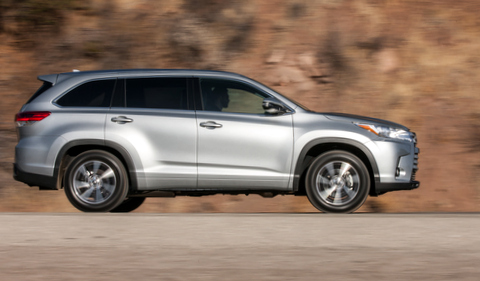
After driving a 2018 Toyota Highlander LT Plus, it was obvious to me that it is ready to take on rivals like the Ford Explorer, Honda Pilot, Chevrolet Traverse, Nissan Pathfinder and Volkswagen Atlas. A powerful standard engine and an enviable resale and repair history make the 2018 Highlander a strong choice. Those concerned with fuel economy can opt for the Highlander Hybrid that delivers class-leading city-fuel-economy figures.
Refreshed in 2017 with only minor exterior changes for 2019, the 2018 Highlander comes in six main trim levels: LE ($31,330), LE Plus ($36,260), XLE ($39,220), SE ($40,440), Limited ($42,430) and Limited Platinum ($45,550). The base LE model come with a 185-horsepower 2.7-liter four-cylinder powering the front wheels through a six-speed automatic transmission. The balance of the lineup is equipped with a standard 295 horsepower V6 with an eight-speed automatic that actually gets better highway fuel economy (27 mpg highway vs. 24 here). All-wheel drive adds $1,460.
Exterior
The biggest styling change for the 2017 Highlander was the grill. It’s huge, following the big-grill trend that’s been stylish for the past few years. Yet it emphasizes the already blunt nose of this midsize SUV, with different models getting different trims. The grill won’t appeal to everybody, but it is certainly distinctive.
Beyond the grill, I generally like the 2018 Toyota Highlander’s look. It’s large, but not imposing; muscular, yet handsome. It has more a squared-off look vs. the rounded Honda Pilot. In this respect, the Highlander looks the part of a more traditional, slabbed-sided SUV.
Interior
All things considered, the 2018 Highlander’s interior is one of its strong points. High quality looking materials, along with exemplary fit and finish, elevate this once pedestrian interior to entry-level luxury status.
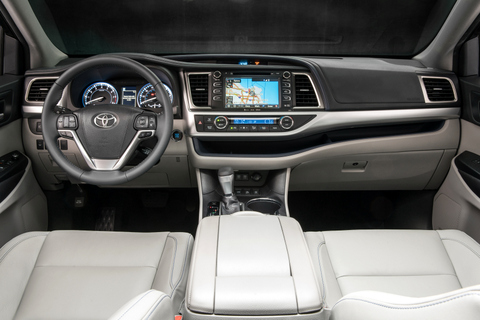
Comfortable front- and second-row seats are great for long drives, and small ones in the third row will be satisfied, although adults will most likely skip it. Our LE Plus came with a second-row bench seat, allowing eight-passenger seating. Other models are equipped with two second-row captain’s seats.
The Highlander’s wide dash is logically laid out, with secondary controls grouped to the left of the steering wheel. The two-tier look is both clean and functional; there’s plenty of room to store a few charging smartphones on a shelf about halfway up the dashboard and Toyota has even thought to include pass-troughs for USB chargers to cut down on clutter. Every trim gets its own finishes.
Storage cubbies, cup holders and USB ports abound—all helpful for making trips less stressful. Of note is the—pick an adjective: enormous, gargantuan, massive—roll-top center console. Opened, it can swallow a large handbag or a couple laptop computers.
All Highlanders have a central touch screen for audio and information functionality; 6.1 inches in lower trims and 8.0 inches in higher ones. While its various infotainment systems lack Apple CarPlay and Android Auto, they are up-to-date in every other aspect.
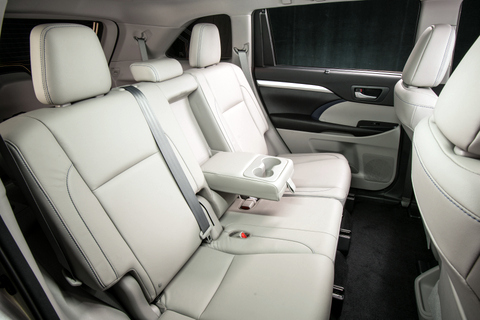
The 60/40 split way back seats fold flat to expand cargo space from 13.8 cubic feet—enough for a week’s worth of groceries or a stroller—to 42 cubic feet. Stow the second row and space expands to 82.6 cubic feet.
One of the 2018 Toyota Highlander’s biggest advantages over competitors is its high level of standard active safety technology; some rivals offer these features only on more expensive trim levels. Called Toyota Safety Sense P (TSS-P), the grouping includes pre-collision warning and braking with pedestrian detection, lane-departure warning, lane-keep assist, automatic high beams and adaptive cruise control. XLE trims and above also have blind-spot monitoring with rear cross-traffic alert.
My favorite Highlander feature was the handy flip-up rear hatch window. It was easy to load and unload the rear without opening the entire tailgate. All but base models include a power-operated tailgate.
Driving Impressions
At 16-feet long and more than six-feet wide, the 2018 Highlander is a fairly large vehicle. In spite of the size, outward visibility is quite good, with the standard rear view camera and blind spot monitoring system notably helping.
I found the 2018 Toyota Highlander LE Plus to be a soothing respite to the bustle of noisy city traffic—well soundproofed, nicely appointed and easy to drive on a daily basis. All V6 Highlanders have an auto start-stop system for improved fuel economy. It cut off the engine at stops and started it up again as soon as my foot left the brake pedal. It was mostly unobtrusive and is among the best of these systems.
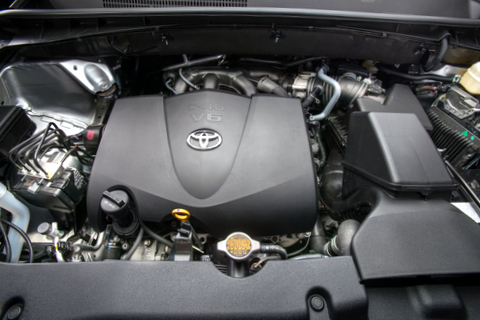
Power from the V6 didn’t dazzle me, but it was beyond adequate when merging into traffic and when I needed some punch to pass a slower car. The eight-speed transmission acted as if wasn’t there with smooth, seamless shifts.
I thought the Highlander cornered quite well for a large vehicle, with prompt turn-in response and controlled body lean. Steering was nicely weighted with decent feedback, but was a little heavy at slow speeds. Bumps and ruts for the most part were generally shrugged off by the fully independent suspension.
I did find the brakes a bit touchy. It took a few days to become acclimated, and then they seemed normal.
During our time with the Highlander we did the usual things that most of us do in a week: a variety of errands, a grocery store run, visiting friends and family, including a 300-mile round trip to spend a weekend with our oldest son. In total, we tallied 421 miles and turned the keys back to Toyota averaging just a little more than 25 mpg. Managing Editor of Clean Fleet Report and husband Larry treated me to a wonderful dinner out for beating the EPA combined rating of 23 mpg.
Should You Buy a 2018 Model Instead of a 2019?
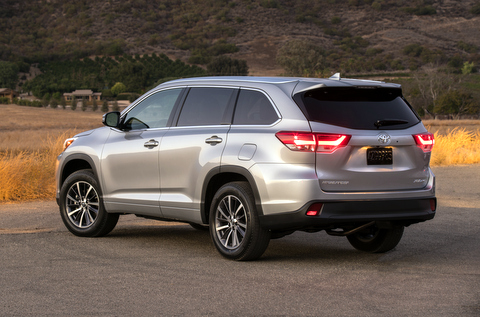
Yes, if you’re unexcited about detail changes Toyota made to the 2019. Buying a ’18 will help you duck the model-year price escalation. And it will get you a crossover that’s the 2019 Highlander’s visual and mechanical duplicate.
Top safety ratings and Toyota reliability are selling points for all Highlanders. So is resale value and the percentage of it you’ll sacrifice by purchasing a 2018 instead of a 2019 will be negligible within just a few years.
They’re out there (the 2018s) since according to industry information om Automotive News, Toyota is offering incentives to dealers to help move them off the lots.
Related Stories You Might Enjoy—Other Three-Row SUVs
Road Test: 7 Things to Know About the 2019 Subaru Ascent
Detroit Auto Show: 2020 Ford Explorer Goes Hybrid
Comparison Test: Two 2018 Volkswagen Atlas
Road Test: 2018 Volkswagen Tiguan
Road Test: 2017 Nissan PathfinRoad Test
Road Test: 2018 Toyota Highlander Hybrid
Road Test: 2018 Hyundai Santa Fe Sport
Flash Drive: 2018 Buick Enclave
Road Test: 2017 Mitsubishi Outlander
Road Test: 2016 Kia Sorento
Road Test: 2014 Jeep Grand Cherokee
Make sure to sign up for the Clean Fleet Report newsletter (top right of page) to be notified of all new stories and vehicle reviews.
Disclosure:
Clean Fleet Report is loaned free test vehicles from automakers to evaluate, typically for a week at a time. Our road tests are based on this one-week drive of a new vehicle. Because of this we don’t address issues such as long-term reliability or total cost of ownership. In addition, we are often invited to manufacturer events highlighting new vehicles or technology. As part of these events we may be offered free transportation, lodging or meals. We do our best to present our unvarnished evaluations of vehicles and news irrespective of these inducements.
Our focus is on vehicles that offer the best fuel economy in their class, which leads us to emphasize electric cars, plug-in hybrids, hybrids and diesels. We also feature those efficient gas-powered vehicles that are among the top mpg vehicles in their class. In addition, we aim to offer reviews and news on advanced technology and the alternative fuel vehicle market. We welcome any feedback from vehicle owners and are dedicated to providing a forum for alternative viewpoints. Please let us know your views at publisher@cleanfleetreport.com.

7 thoughts on “Flash Drive: 2018 Toyota Highlander”